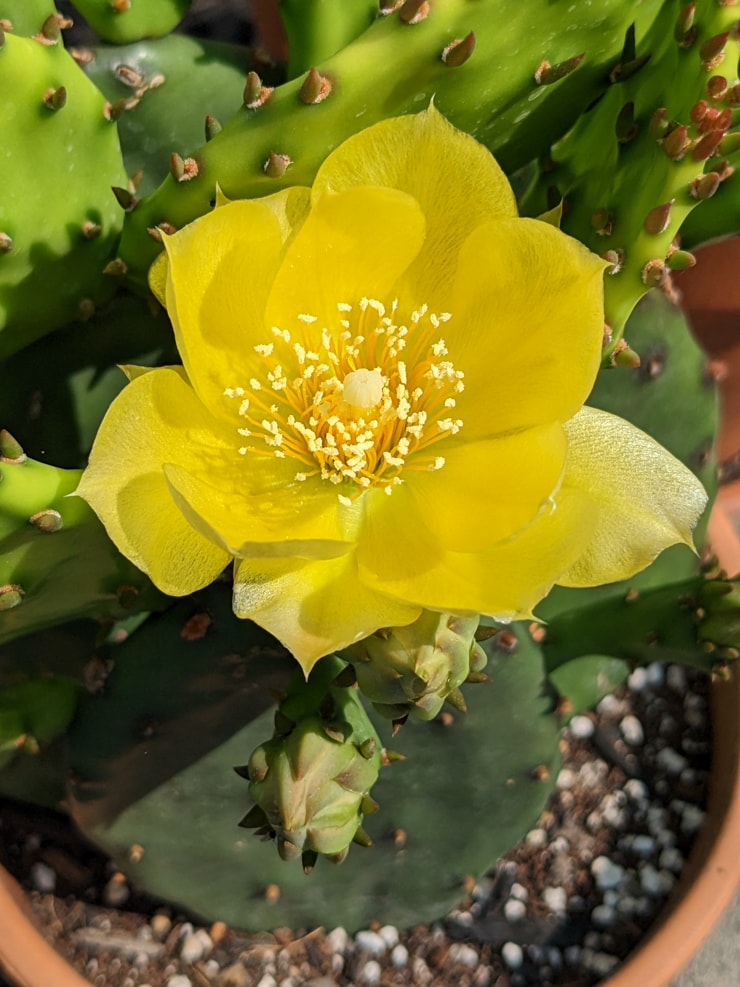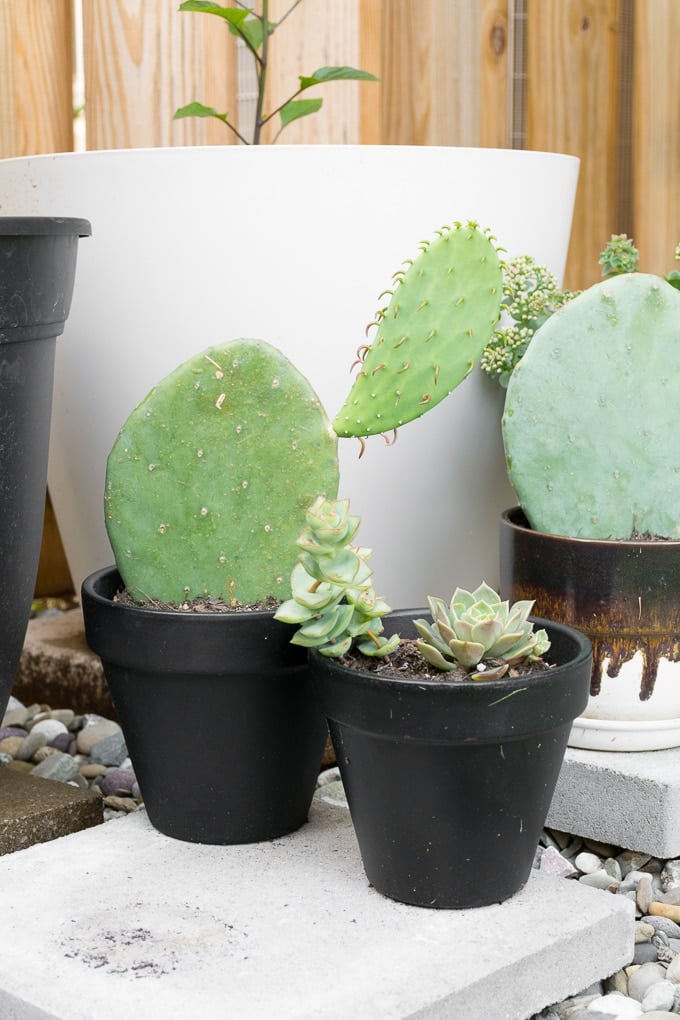This guide shares tips for prickly pear cactus care. Learn how to help this classic cactus thrive!
How to care for prickly pear cactus
Prickly pear cactus—otherwise known as Opuntia, Indian fig, Bunny Ears, and more—is a beautiful, hardy, and fast-growing genus of flowering plants in the cactus family Cactaceae. The plant has classic large, flat, green paddles, and when it matures, it can develop red, orange, and yellow flowers.
The most common variety of prickly pear is Opuntia ficus-indica, which is what I have. A quick note that many of you are likely finding this guide searching for info on caring for prickly pears outdoors.
While I have had my prickly pears outdoors, I grow them in pots so I can take them inside. So most of my information will be related to caring for potted prickly pear. However, I’l sprinkle in some additional information about caring for the plants outdoors—my neighbors have a whole hedge of them!
- Prickly pear cactus care overview
- Where is prickly pear cactus from?
- What does a prickly pear cactus look like?
- Are prickly pear cactus easy to grow?
- How large does a prickly pear cactus get?
- How fast do prickly pear cactus grow?
- What is the preferred soil?
- Light & water requirements
- Is prickly pear cactus is edible?
- Propagating prickly pear cactus pads
- In conclusion…

Prickly pear cactus care overview
- Prickly pear cactus (Opuntia) is a hardy plant with large, flat green paddles covered in small sharp thorns.
- Can develop bright flowers out of the areola; after blooming, produces red edible fruit.
- Indoors, they tolerate various temperatures and need a light of bright light.
- Planted in the ground outdoors, prickly pear is perennial and cold-hardy down to USDA zone 4; avoid letting the plant freeze in pots outdoors.
- Plant in well-draining succulent or cactus soil, mimicking their natural rocky or sandy habitats.
- Water minimally, allowing the soil to dry out between waterings.
- Height varies, ranging from a few inches to 20 feet tall; can spread up to 15 feet, often used as borders or hedges.
- Produces several new paddles per year in ideal conditions; paddles contain a liquid similar to aloe vera gel.
- Prickly pear pads are easy to propagate by letting a removed pad callus over; plant in well-draining soil and watering moderately.

Where is prickly pear cactus from?
Prickly pear cactus is native to the Americas and reminds me of a classic cactus you’d see in an old western movie. They don’t really grow in the wild where I’m at in America, but you can grow them as perennials.
If you’re down south, you might think the old western thing sounds funny because you see them everywhere. My friend in Georgia runs them over with her lawnmower 🙂 Isn’t it funny how differently we view certain plants based on where we live and how much of a nuisance they are to us?

What does a prickly pear cactus look like?
Each large, flat paddle is covered in small sharp thorns and has an areola on its tip. When the cactus blossoms, the flowers grow out of the areola. Note that like many types of cactus, prickly pear plants produce loose barbed thorns that can attach to things.
But the paddles aren’t all thorns. And the liquid inside of the paddles works just like aloe vera gel! It does take a few years to mature and bloom. Despite the wait for blooms, the prickly pear cactus is lovely with just paddles and is quite rewarding for gardeners and plant lovers with a variety of skill levels.

Are prickly pear cactus easy to grow?
Yes, prickly pears are quite easy to grow. Indoors, prickly pear cactus will tolerate a variety of temperatures. There’s really not much you need to worry about if you have it in a pot inside. And you can spoil yours by giving them some nice sun outdoors in the summer, which is what I do.
Established outdoor plants can tolerate extreme heat during the day and low temperatures at night. However, you shouldn’t let prickly pears planted outdoors freeze if they are in pots. They are not big fans.
That said, you can grow them as perennials in many areas with four seasons—down to USDA zone 4. They just might just die back depending on how established they are in the ground. We have had temperatures here down into the single digits this winter, and my neighbors big hedge of pears is going strong—just a little limp. They rebound every spring!

How large does a prickly pear cactus get?
The height range for prickly pear cactus varies greatly by the type of oputina you have. A single paddle baby plant can be a few inches tall, while established, mature plants can be up to 20 feet tall.
These larger prickly pears are typically grown outdoors in areas that enjoy abundant sun. Smaller varieties can be easily grown indoors and can get a few feet high. You can even grow larger varieties indoors—they just likely won’t reach their full potential.
Prickly pear cactus can spread up to 15 feet. For this reason, many use them as borders or along the sides of structures. They have a hedge-like appearance when they mature.

How fast do prickly pear cactus grow?
Prickly pear cactus generally grows at an average speed. In ideal care conditions, plants can product several new paddles per year. The first picture below is of a few single pads I’d rooted over the winter.
The second photo was taken midway through the summer. You can see that the plant had already produced four arms, with one of those arms extending another arm. Pretty cool.


What is the preferred soil?
As houseplants, any well-draining succulent or cactus soil works great. This is the best way to mimic the plant’s natural environment, where they are often found growing in rocky or sandy soil. Outdoors, you may need to amend your soil before planting.
We have a very heavy, clay-based soil where we live. So anything I put in the ground, I amend the soil around the root ball with some leaf compost and top soil. This adds nutrients while also loosening things up and preventing too much water-logging.
I also read that prickly pear plants can have benefits for soil in some environments. Some plant it in hedges as erosion control and find that it helps to considerably improve the soil. It also helps to reduce runoff. Prickly pear plants have also been used in Tunisia and Algeria to slow and direct sand movement and enhance the restoration of vegetative cover.

Light & water requirements
Like most cactus varieties, prickly pear prefers a lot of light. Established plans can tolerate heavy sun exposure and hot temperatures during the peak season. In the cooler months and winter, they are just fine indoors with bright indirect light from a window.
Another similarity with other cactus varieties is their need for water. You can let the soil dry out between watering and water only a handful of times during the entire cool winter season. While propagating my prickly pear paddles, I watered the soil I had them rooting in when it became dry a few inches down.
Once your plant is established, you can wait until it begins to look just a tad wrinkly before giving it a thorough watering. Don’t over-water, and make sure to allow all excess water to drain. If the roots sit in water, they will begin to rot (see photo with black spots below).
You’ll see the signs on your cactus, too—the base will begin turning brown, and the cactus will probably begin looking soft and a bit droopy. Once you see the brown, your cactus is beyond saving. (Though you might be able to salvage an unaffected pad and propagate it!)
If you have your prickly pear plants in the ground, chances are you will just be able to let mother nature handle watering. They are very resilient and drought tolerant, so a thorough soaking rain can keep them happy for quite a while.

Is prickly pear cactus is edible?
Yes! I actually didn’t know this when I got my first cuttings to grow. After flowering, the prickly pear produces fruits. The pads and fruit can be consumed by humans and animals and are apparently quite tasty. If you see a recipe calling for “nopales,” that is referring to the prickly pear’s pads.
Its fruits—or its prickly pears—are bright and said to have a sweet, citrus-like flavor. The juice has a lemon-lime flavor. I don’t have any experience eating any part of the plant, though. So I’d recommend doing your research thoroughly to make sure you are preparing them correctly using expert sources.

Propagating prickly pear cactus pads
Prickly pear cactus pads are incredibly easy to propagate! Check out my tutorial on How to Propagate Prickly Pear Cactus for a detailed guide with pics. Here is an overview of the process!
- Remove a pad from an existing plant; let the cut end callus over for a few days
- Stick in a small pot with well-draining soil
- Water when the top several inches of soil dries out; you’ll need more moisture than the prickly pear usually needs to encourage rooting
- Once you can gently tug the pad and get resistance, back off watering and let the soil dry out completely before watering again.

In conclusion…
Caring for these resilient plants can help you add a unique aesthetic with their distinctive paddles and bright flowers. Remember, the key to a healthy prickly pear lies in understanding its light, soil, and water needs, which mimic its natural desert habitat.
Have you cared for or propagated a prickly pear plant? What challenges have you faced, or what unique tips can you offer? Let me know if the comments below. Happy planting 🙂
Pin my tips for prickly pear cactus care!


Brittany is a seasoned DIY home and garden expert, running a creative brand since 2014 that inspires others with approachable plant care guides, woodworking tutorials, and decor projects. She is a certified project manager and has completed extensive coursework in the art and science of growing your own plants. Her work has been recognized by major publications, and she routinely collaborates with fellow DIY industry leaders—but her favorite thing to do is inspire you! Learn more about her here.

hello
thank you for helping me understanding how to propagate my Cactus. I have got a Cactus with so much pup attach to the mother plant.it was from the Caribbean these Cactus we do eat as a side dish.it looks prickly pear Cactus. but its not
Of course, good luck!